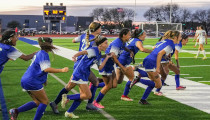The act of hazing has mostly been associated with college fraternities and sororities, but it is becoming a more frequent occurrence in high school athletics. Hazing certainly is not new; however, the degree to which it is reported in the news today is. Social media allows the average fan, player and parent to get a more in-depth view into what actually goes on in players' lives.
The willingness for high schools to admit that bullying is a real and dangerous problem facing many students today has led administrators and athletic directors to take a much closer look at hazing rituals on their campuses. Ritual hazing might have been looked at by administrators a few years ago as kids being kids, but now there is no room for activities that degrade or defame anyone. Strict rules are in place to punish student-athletes involved in hazing students and athletes. More than ever, coaches need to be proactive to not only protect their own coaching careers, but to ensure the safety and well-being of those they coach.
The Current Environment
Coaches who are guilty of turning a blind eye to hazing incidents are fired. In a case in California, some members of a varsity girls soccer team forced four freshman girls to drink alcohol until the girls vomited or collapsed. In New Jersey, freshmen soccer players were physically abused and thrown in the mud as part of an annual hazing event. The head coach and two assistants were fired because they allowed it to happen. In New York, four members of a high school football team sodomized junior varsity players. The players were charged with a crime, and the coaches were fired (Martens, R., 2012). These incidents represent a very small sample of a problem that seems to be epidemic in high school athletics but reinforce the need for all coaches to take the issue seriously.
Hazing, Bullying – How They Can Feed Off Each Other
One distinction that should be made about hazing is that bullying and hazing are not the same thing. Hazing is a form of bullying, but hazing is seen as temporary. They are different from each other because bullies usually act alone to single out someone they perceive as weak. Bullies want to exclude a person from a group.
Hazing is an act often performed by a group. The act of hazing is done to individuals who want to join a group. Being put through a hazing ritual usually ends with the person or persons being allowed into the group. Bullying continues with no end in sight. Both bullying and hazing involve mental or physical discomfort, embarrassment, harassment or ridicule of the victim or victims (Martens, R. 2012).
In bullying there is no consent by the victim, where as in hazing there is an air of implied consent by the victim or victims (stophazing.org. 2013). Hazing is an activity defined as any requirement that humiliates, degrades, abuses or endangers individuals. The victims’willingness to participate does not eliminate the activity from being hazing (Tokar, K., & Stewart, C. 2010). With this definition in mind more and more high school “rituals” may be seen as hazing, but neither act has any place in high school athletics.
How to Identify Hazing
Schools should review all traditions of extracurricular groups. The idea that football is the only area where hazing occurs is false. Cheerleading, band and choir programs all have had hazing associated with them. Coaches and faculty members need to be aware of what goes on in each group. Hazing arises in two ways – one is a lack of supervision and another is a failure to address it.
Lack of supervision is a huge starting point for hazing. The first issue is the coaches’willingness to condone behavior demonstrated by the team. This goes far beyond allowing an athlete to get away with an occasional foul word. No one can possibly prevent athletes from getting in trouble if that is their intent, but coaches need to set clear and explicit rules, supervise all team activities and take a no-tolerance approach on hazing. A coach has a moral obligation to protect and look after student-athletes in his or her charge in lieu of the parent being present. Parents place a great deal of trust in their child’s coach. A coach who allows hazing to occur is violating the trust placed in him or her and is breaking the law.
The second issue arises when coaches fail to address and define hazing. Administration sets zero-tolerance policies, but coaches must adhere to those policies and do so in good faith. Without a unified front from both coaches and administration, more serious incidents can arise and create negative cultures for entire communities.
In creating team rules, discover what policies the district subscribes to and have clarifying discussions with the athletic director and principal on what behaviors are and are not acceptable. A school’s lack of action could be looked at as partially to blame for hazing incidents, but it does not stop coaches from being proactive to try to find solutions. Most educators, coaches and administrators agree the best way to end hazing is to begin by sending a clear anti-hazing message. Then, implement a strong anti-hazing policy, clearly communicating it to all parties, and enforcing the policy when incidents occur (Nuwer, H., 2010).
How to Address Hazing in Your Program
Hazing is also problematic because it is inherently secretive. Schools and athletic programs should never cover up hazing incidents. Hank Nuwer, in his book, When Rites become Wrongs, calls this the “conspiracy of silence.” He states that this act feeds off itself and becomes difficult to stop (Nuwer, H., 2000). If an episode of hazing is witnessed, it should be reported immediately so it can be dealt with immediately.
School administrators and athletic staff should not be nervous about dealing with hazing because they feel uncomfortable about how to approach the problem. They simple need to seek outside help. Many groups have been established to help high schools deal with the problem of hazing. Hazing is a widespread problem and the problems faced at their high school are not unique. The key is not to try and combat the problem alone; instead seek help, and make it a focus of the entire student body.
Create Positive Activities
Some players and coaches believe hazing helps in team building, but this is farthest from the case as it actually undermines it. Team building involves trust. Coaches can and should provide activities that support team building. The team could do a movie night, team dinner, laser tag or a team retreat with proper adult supervision.
Establishing welcome programs for first-year and transfer students can reduce the chances of hazing rituals. Mentoring programs are more constructive than pledging rituals in welcoming new members to a group or new students to a school. Assign a senior mentor to every new player and talk to the seniors about the responsibility they carry in creating safe environments. It is the mentor’s job to make sure that the transition to varsity is smooth and that the new player is made to feel welcome.
Creating an environment free from hazing may be impossible but there are steps that can be taken to help eliminate hazing. Following these steps will create an environment in which hazing is not accepted. As a final note, it is always helpful to have students and parents sign a written statement agreeing to a policy that raises awareness of hazing and instills a sense of accountability in all stakeholders. When you unify the team in creating safe environments, everyone can enjoy athletics.
Reference:
ABC News. (2013). How to stop hazing. Retrieved from http://abcnews.go.com/US/story?id=90209
Chicago Sun-Times. (2013). Judge dismisses lawsuit in maine west hazing case. Retrieved from http://chicago.cbslocal.com/2013/10/15/judge-dismisses-lawsuit-in-maine-west-hazing-case/
Janssen, Jeff. (2012). Preventing hazing on your team. Team Captain’s Network. Janssen Sports Leadership Center. Retrieved from http://www.teamcaptainsnetwork.com/public/226.cfm
Kuczynski-Brown, Alex. (2013). West maine high school hazing: another incident involving coach Michael DiVincenzo reported. Huff Post. Education. November 2012. Retrieved from http://www.huffingtonpost.com/2012/11/26/another-hazing-incident-i_n_2193287.html
Martens, Rainer. (2012). Successful Coaching. 4th Edition. Pg 94-95. American Sports Education Program
Nuwer, Hank. (2000). High school hazing: when rights become wrongs. Pg 122-128. Franklin Watts, Inc.
Nuwer, Hank. (2010) Stophazing.org. Retrieved from http://www.stophazing.org/athletic_hazing/index.htm
Tokar, K., & Stewart, C. (2010). Defining High School Hazing: Control Through Clarity. Physical Educator, 67(4), 204-208
Jeff Jonas
Jeff Jonas has been a high school science, math and PE teacher for 26 years and a high school coach for 31 years. A graduate of San Francisco State University, Jonas has coached football, boys and girls basketball, baseball, and softball. He has been a part of section championship teams in football, basketball and softball.
Most Recent Articles
- 2025 Performing Arts Education and Creative Industry Meeting Materials
- Boys Lacrosse Season Preview - 2025
- Girls Lacrosse Season Preview - 2025
- nfhs news Risk Minimization Focus of 2025-26 High School Spirit Rules Changes
- nfhs news Supporting High Schools, State Associations to Determine Eligibility, Transfer Rules






